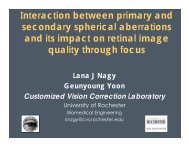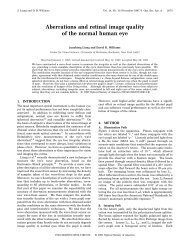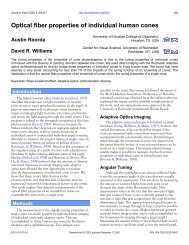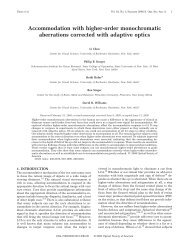Compensation of corneal aberrations by the ... - Journal of Vision
Compensation of corneal aberrations by the ... - Journal of Vision
Compensation of corneal aberrations by the ... - Journal of Vision
Create successful ePaper yourself
Turn your PDF publications into a flip-book with our unique Google optimized e-Paper software.
Artal, Guirao, Berrio & Williams 2combining <strong>the</strong>se two sets <strong>of</strong> data, <strong>the</strong> <strong>aberrations</strong> <strong>of</strong> <strong>the</strong> internaloptics were estimated <strong>by</strong> direct subtraction. Then <strong>the</strong> WA <strong>of</strong> <strong>the</strong>eye was measured after neutralizing <strong>the</strong> cornea using swimminggoggles filled with saline water. The <strong>aberrations</strong> measured with <strong>the</strong>filled goggles correspond approximately to those <strong>of</strong> <strong>the</strong> internalocular optics. The crystalline lens is <strong>the</strong> most important contributorto <strong>the</strong> <strong>aberrations</strong> <strong>of</strong> <strong>the</strong> internal ocular optics that also includes<strong>the</strong> posterior surface <strong>of</strong> <strong>the</strong> cornea and <strong>the</strong> ocular media.MethodsFigure 1 shows a schematic diagram <strong>of</strong> <strong>the</strong> experimentalprocedure. From <strong>the</strong> <strong>aberrations</strong> <strong>of</strong> <strong>the</strong> complete eye and<strong>the</strong> cornea, those <strong>of</strong> <strong>the</strong> internal optics are estimated <strong>by</strong>direct subtraction. The <strong>aberrations</strong> <strong>of</strong> <strong>the</strong> internal opticsare directly measured after neutralizing <strong>the</strong> <strong>aberrations</strong> <strong>of</strong><strong>the</strong> first <strong>corneal</strong> surface.internal optics = eye - cornea+ =internal optics (directly)optics to <strong>the</strong> overall ocular aberration were evaluated. Thegeometric center <strong>of</strong> <strong>the</strong> pupil was used as <strong>the</strong> reference pointfor <strong>the</strong> registration between H-S and <strong>corneal</strong> measurements.In a simple model with <strong>the</strong> two series <strong>of</strong> Zernike coefficientsfor <strong>the</strong> cornea and <strong>the</strong> eye, <strong>the</strong> <strong>aberrations</strong> <strong>of</strong> <strong>the</strong> internaloptics were obtained <strong>by</strong> direct subtraction <strong>of</strong> each pair <strong>of</strong>coefficients. It was assumed that <strong>the</strong> wave <strong>aberrations</strong> were<strong>the</strong> same axially along small distances.In addition, <strong>the</strong> WA for <strong>the</strong> internal optics was directlymeasured with <strong>the</strong> H-S sensor when refraction and<strong>aberrations</strong> <strong>of</strong> <strong>the</strong> <strong>corneal</strong> surface were cancelled <strong>by</strong>immersing <strong>the</strong> eye in saline water using swimming goggles(Millodot & Sivak, 1979). Light reached <strong>the</strong> eye through ahole along <strong>the</strong> optical axis <strong>of</strong> <strong>the</strong> goggles that was covered <strong>by</strong>a high-quality optical window. When <strong>the</strong> <strong>corneal</strong> surfacepower is cancelled, <strong>the</strong> eye becomes highly hyperopic. Toobtain H-S images adequate for processing, this large defocuswas compensated with a Badal optometer formed <strong>by</strong> twophotographic objectives (Figure 2B). By using thisprocedure, several problems may affect <strong>the</strong> estimates <strong>of</strong> <strong>the</strong><strong>aberrations</strong> <strong>of</strong> <strong>the</strong> internal optics. When <strong>the</strong> H-S sensor isused at <strong>the</strong> extreme vergence required for correcting <strong>the</strong> eye’shyperopia, <strong>the</strong> apparatus itself introduces large <strong>aberrations</strong>that may affect <strong>the</strong> results. This issue was overcome <strong>by</strong> usinga reference image <strong>of</strong> <strong>the</strong> system, recorded in <strong>the</strong> sameconditions, to compute <strong>the</strong> <strong>aberrations</strong> <strong>of</strong> <strong>the</strong> internal ocularoptics. This removes any systematic <strong>aberrations</strong> present in<strong>the</strong> apparatus. In addition, <strong>the</strong> optical window placed infront <strong>of</strong> <strong>the</strong> goggles and <strong>the</strong> water act as a plane parallel platethat introduces spherical aberration for those vergences. Thespherical aberration was calculated with a ray-tracingprogram and incorporated into <strong>the</strong> data analysis.+ =(b)hyperopiacorrection(46 D)salinewaterFigure 1. Schematic diagram <strong>of</strong> <strong>the</strong> experiments performed.The WA <strong>of</strong> <strong>the</strong> eye was measured with a Hartmann-Shack (H-S) sensor (Liang, Grimm, Goelz, & Bille, 1994; Liang& Williams, 1997; Prieto, Vargas-Martín, Goelz, & Artal, 2000).A narrow infrared beam that acts as a beacon source isproduced <strong>by</strong> a super-luminescent diode and is projectedinto <strong>the</strong> subject's retina. In <strong>the</strong> second pass, a microlensarray, conjugated with <strong>the</strong> eye pupil, produces an image <strong>of</strong>spots on a charged-coupled device camera (CCD) (Figure2A). The relative displacements <strong>of</strong> <strong>the</strong> spots areproportional to <strong>the</strong> WA local slopes. Then <strong>the</strong> WA isreconstructed as a Zernike polynomial expansion (Noll,1976). The <strong>aberrations</strong> introduced <strong>by</strong> <strong>the</strong> anterior surface<strong>of</strong> <strong>the</strong> cornea were calculated from <strong>the</strong> <strong>corneal</strong> shape,measured <strong>by</strong> a videokeratographic device (MasterVue<strong>corneal</strong> topography system; Humphrey Instruments, SanLeandro, CA). Once <strong>the</strong> anterior <strong>corneal</strong> surface wasmodeled, <strong>the</strong> difference in optical path between <strong>the</strong> chiefray and a marginal ray over <strong>the</strong> pupil yields <strong>the</strong> WA for <strong>the</strong>cornea (Guirao & Artal, 2000). From <strong>the</strong>se two WA maps,<strong>the</strong> relative contributions <strong>of</strong> <strong>the</strong> cornea and <strong>the</strong> internalfocuscorrectormicrolensarrayCCD(a)SLDobjective(50 mm)objective(50 mm)gogglesFigure 2. A. Schematic diagram <strong>of</strong> <strong>the</strong> Hartmann-Shack wavefrontsensor used to measure <strong>the</strong> <strong>aberrations</strong> <strong>of</strong> <strong>the</strong> completeeye. SLD indicates super-luminescent source; CCD, chargedcoupleddevice camera. B. Diagram <strong>of</strong> <strong>the</strong> part <strong>of</strong> <strong>the</strong> set-upmodified to measure <strong>the</strong> aberration <strong>of</strong> <strong>the</strong> internal optics. Theeye was equipped with swimming goggles filled with salinewater. Defocus was compensated <strong>by</strong> <strong>the</strong> relative position <strong>of</strong> <strong>the</strong>two 50-mm objectives.







